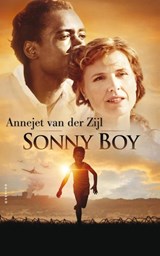The first lines of Annejet van der Zijl, The Boy Between Worlds [Sonny Boy], translated by Kristen Gehrman
10 september 2019Kristen Gehrman vertaalde Annejet van der Zijls Sonny Boy in het Engels als The Boy Between Worlds. We vroegen haar de eerste zinnen van haar vertaling toe te lichten. Over flow in vertaling en rivieren, hoe water kan trekken en likken - en dan in het Engels.
N.B. Lees op Athenaeum.nl ook een fragment uit Bernhard. Een verborgen geschiedenis en onze bespreking van De Amerikaanse prinses. Donderdag 7 november komen Van der Zijl en Kristen Gehrman naar het Spui om over de vertaling te spreken.
Waldemar was een zwemmer.
Waldemar was a swimmer.
The first sentence of Sonny Boy might as well already be in English. Easy. But what comes next is so lyrical and lovely, I was almost afraid to touch it. The images in the first paragraph of The Boy Between Worlds [Sonny Boy] by Annejet van der Zijl are absolutely critical, not only because they introduce us to the main character, Waldemar, and his beloved Suriname (a place many English readers are not familiar with), they also prepare us for the very end of the book, when the story comes full circle in the most poetic, heart-breaking way. But don’t let me give it all away! Since there’s not so much to say about the opening line, I thought I’d look at my translation of three sentences from the opening paragraph about Waldemar’s friend the water:
Als hij ’s ochtends naar school liep, klotste het water nog loom tegen de oevers en stroomde de rivier keurig stroomafwaarts naar de zee. Maar kwam hij ’s middags thuis, dan lagen haar modderige ingewanden meters lager te glanzen in de zon en zochten de sabaku-reigers tussen de gestrande bootjes naar eten. En bij het vallen van de avond leek de rivier door een onzichtbare reuzenkracht stroomopwaarts te worden getrokken en likten de golven plots aan de stammen van de amandelbomen langs de Waterkant.
You know what they say about rhythm, you either have it or you don’t? Well, Annejet van der Zijl’s got rhythm. Her sentences ebb and flow so naturally, from short to long, heavy to light, main clause to sub-clause. If a word-for-word translation won’t suffice, how can I at least capture the steady roll of the sentence, the sound of the current, the rhythm of the waves? Let’s look at the translation of the above, sentence by sentence.
On his way to school in the morning, the water sloshed languidly against the banks as the river flowed to the sea.
Ah loom, what a perfectly lazy-sounding word, luckily we have an appealing equivalent in English, languidly (don’t the L’s just roll of the tongue?). But what about keurig? That one’s trickier: neatly, tidy (tidily?), how to describe a well-mannered river? No matter what I tried, it drew too much attention to itself, so we’re left with ‘as the river flowed to the sea’ (which is, of course, ‘stroomafwaarts’, ‘downstream’). Don’t disrupt the flow, right?
But by the time Waldemar came home in the afternoon, the water level had dropped by several meters; the river’s muddy bowels were left glistening in the sun, and the Sabaku herons would be searching for food among the stranded boats.
I wanted to convey to the English reader that the river constantly changes throughout the day, as opposed to having three separate states: morning, afternoon and night. This meant replacing the Dutch past tense with the English past perfect tense: ‘But by the time Waldemar came home, the water had dropped…’ Then in Dutch we have ‘dan lagen haar modderige ingewanden meters lager te glanzen’. Oh, if only English could be so compact! I had to unpack this a little (hence the semi-colon… now I’m wondering if it’s disruptive?), but I wanted to make sure those ‘modderige ingewanden’ (‘muddy bowels’) got the emphasis they deserved—I mean, what an image!
And when night fell, it was as though the river had suddenly been pulled upstream by a mighty invisible force, and its waves would lick the trunks of the almond trees growing along the Waterfront.
I love this: ‘leek de rivier door een onzichtbare reuzenkracht stroomopwaarts te worden getrokken’. I remember thinking a lot about the verb ‘trekken’ here. Is it a tug, a yank, a jerk or simply a pull? How strong is this giant force? Is it like a giant hand reaching down from the sky or just the steady rotation of the earth? I hesitated about the licking waves as well. It’s true, the Dutch says ‘likten’, literally ‘licked’, but perhaps there’s another word? Sloshing (no, I already used that), slapping (ouch! too rough), caressing (always sounds so sensual). With licking, I just kept thinking about a tired old dog drinking water from a bowl. But sometimes you just have to use what’s there, to trust the image. And really, if you close your eyes and imagine a dark river on a warm summer night, its steady, gentle waves brushing along the banks—it does kind of sound like a dog’s tongue, doesn’t it?
Kristen Gehrman werkt als redacteur, schrijver en vertaler naar het Engels. In 2016 vertaalde ze Lize Spit op Crossing Border. Sindsdien vertaalde ze fragmenten uit het werk van Anne-Fleur van der Heiden, Rob van Essen, Astrid Panis en Aukelien Weverling. Dit is haar eerste boekvertaling.




